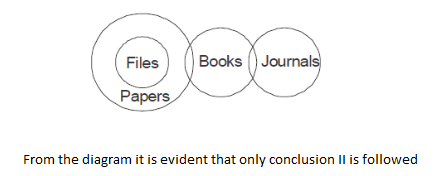Digitization help student to explore and study their academic courses online, as this gives them flexibility and scheduling their learning at their convenience. Kidsfront has prepared unique course material of General Intelligence & Reasoning Statement and conclusion for IBPS PO CWE Exam student. This free online General Intelligence & Reasoning study material for IBPS PO CWE Exam will help students in learning and doing practice on Statement and conclusion topic of IBPS PO CWE Exam General Intelligence & Reasoning. The study material on Statement and conclusion, help IBPS PO CWE Exam General Intelligence & Reasoning students to learn every aspect of Statement and conclusion and prepare themselves for exams by doing online test exercise for Statement and conclusion, as their study progresses in class. Kidsfront provide unique pattern of learning General Intelligence & Reasoning with free online comprehensive study material and loads of IBPS PO CWE Exam General Intelligence & Reasoning Statement and conclusion exercise prepared by the highly professionals team. Students can understand Statement and conclusion concept easily and consolidate their learning by doing practice test on Statement and conclusion regularly till they excel in General Intelligence & Reasoning Statement and conclusion.
 In the following questions, one/two statements are given,
followed by two conclusions 1 and 11. You have to consider the statements to be true even
tf they seem to be at variance from commonly known facts. You have to decide which of
the given conclusions, if any? follows from the given statements.
In the following questions, one/two statements are given,
followed by two conclusions 1 and 11. You have to consider the statements to be true even
tf they seem to be at variance from commonly known facts. You have to decide which of
the given conclusions, if any? follows from the given statements. Correct Answer Is : Only conclusion II follows
Correct Answer Is : Only conclusion II follows In the following questions, two statements are given
followed by two conclusions I and II. You have to consider the two statements to be
true even if they seem to be at variance from commonly known facts. You have to
decide which of the given conclusions, if any, follow from the given tatements.
In the following questions, two statements are given
followed by two conclusions I and II. You have to consider the two statements to be
true even if they seem to be at variance from commonly known facts. You have to
decide which of the given conclusions, if any, follow from the given tatements. Correct Answer Is : Conclusion I and II follows
Correct Answer Is : Conclusion I and II follows In the following questions, two statements are given followed by two conclusions I and II. You have to consider the two statements to be
true even if they seem to be at variance from commonly known facts. You have to decide which of the given conclusions, if any, follow from the given statements.
In the following questions, two statements are given followed by two conclusions I and II. You have to consider the two statements to be
true even if they seem to be at variance from commonly known facts. You have to decide which of the given conclusions, if any, follow from the given statements. Correct Answer Is : None of them
Correct Answer Is : None of them In each of the following questions, one/ two statements are given followed by two conclusions/ assumptions, I and II. You have to consider the staements to be true, even if they seen to be at variance from commonly known facts. You are to decide which of the given conclusions/ assumptions can definitely be drawn from the given statements. Indicate your answer.
In each of the following questions, one/ two statements are given followed by two conclusions/ assumptions, I and II. You have to consider the staements to be true, even if they seen to be at variance from commonly known facts. You are to decide which of the given conclusions/ assumptions can definitely be drawn from the given statements. Indicate your answer. Correct Answer Is : Only conclusion I follows
Correct Answer Is : Only conclusion I follows In each of the following questions, one/ two statements are given followed by two conclusions/ assumptions, I and II. You have to consider the staements to be true, even if they seen to be at variance from commonly known facts. You are to decide which of the given conclusions/ assumptions can definitely be drawn from the given statements. Indicate your answer.
In each of the following questions, one/ two statements are given followed by two conclusions/ assumptions, I and II. You have to consider the staements to be true, even if they seen to be at variance from commonly known facts. You are to decide which of the given conclusions/ assumptions can definitely be drawn from the given statements. Indicate your answer. Correct Answer Is : Only I is implicit
Correct Answer Is : Only I is implicit Some statements are given followed by two Conclusions I and II. You have to consider the statements to be true, even if they seem to be at variance from commonly known facts. You are to decide which of the given conclusions can definitely be drawn from the given statements. Indicate your answer.
Some statements are given followed by two Conclusions I and II. You have to consider the statements to be true, even if they seem to be at variance from commonly known facts. You are to decide which of the given conclusions can definitely be drawn from the given statements. Indicate your answer.
 Correct Answer Is : Only Conclusion II follows
Correct Answer Is : Only Conclusion II follows